OB Learning Journal: Reflections on Theory and Practice in Workplace
VerifiedAdded on 2023/06/11
|10
|3187
|247
Journal and Reflective Writing
AI Summary
This organizational behavior learning journal reflects on the applicability of various OB topics in a real-world workplace setting. It covers assessing, influencing, and rewarding employee performance, organizational processes and behavior, leadership styles, and organizational justice and employee well-being. The journal explores the discrepancies between theory and practice, using personal experiences and observations from the author's organization to illustrate key concepts. It discusses the impact of performance assessment strategies, employee motivation techniques, organizational processes, leadership styles, and workplace conditions on employee performance and organizational culture. The reflections provide insights into the challenges and opportunities of applying OB theories in a dynamic organizational environment. Desklib provides solved assignments for students.
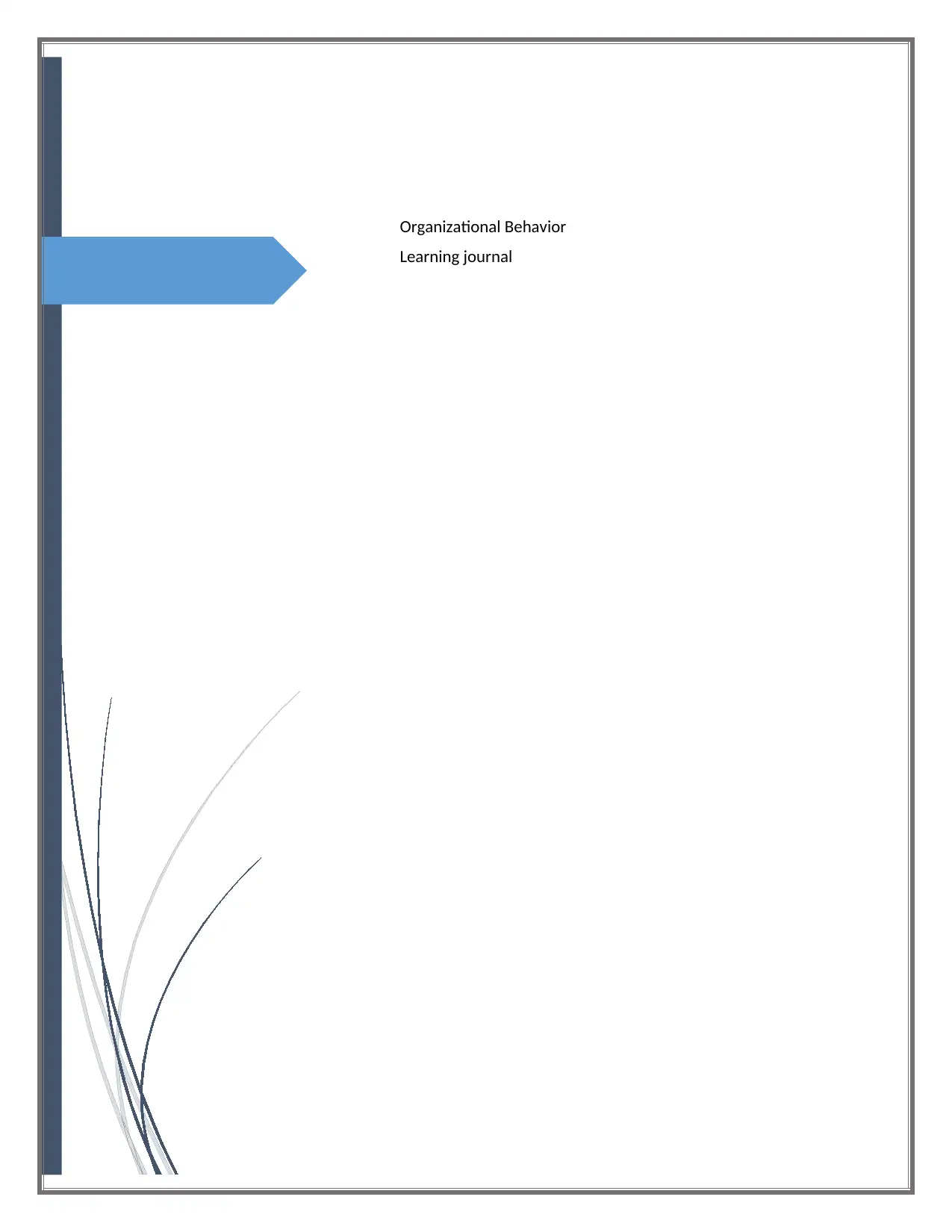
Organizational Behavior
Learning journal
Learning journal
Paraphrase This Document
Need a fresh take? Get an instant paraphrase of this document with our AI Paraphraser
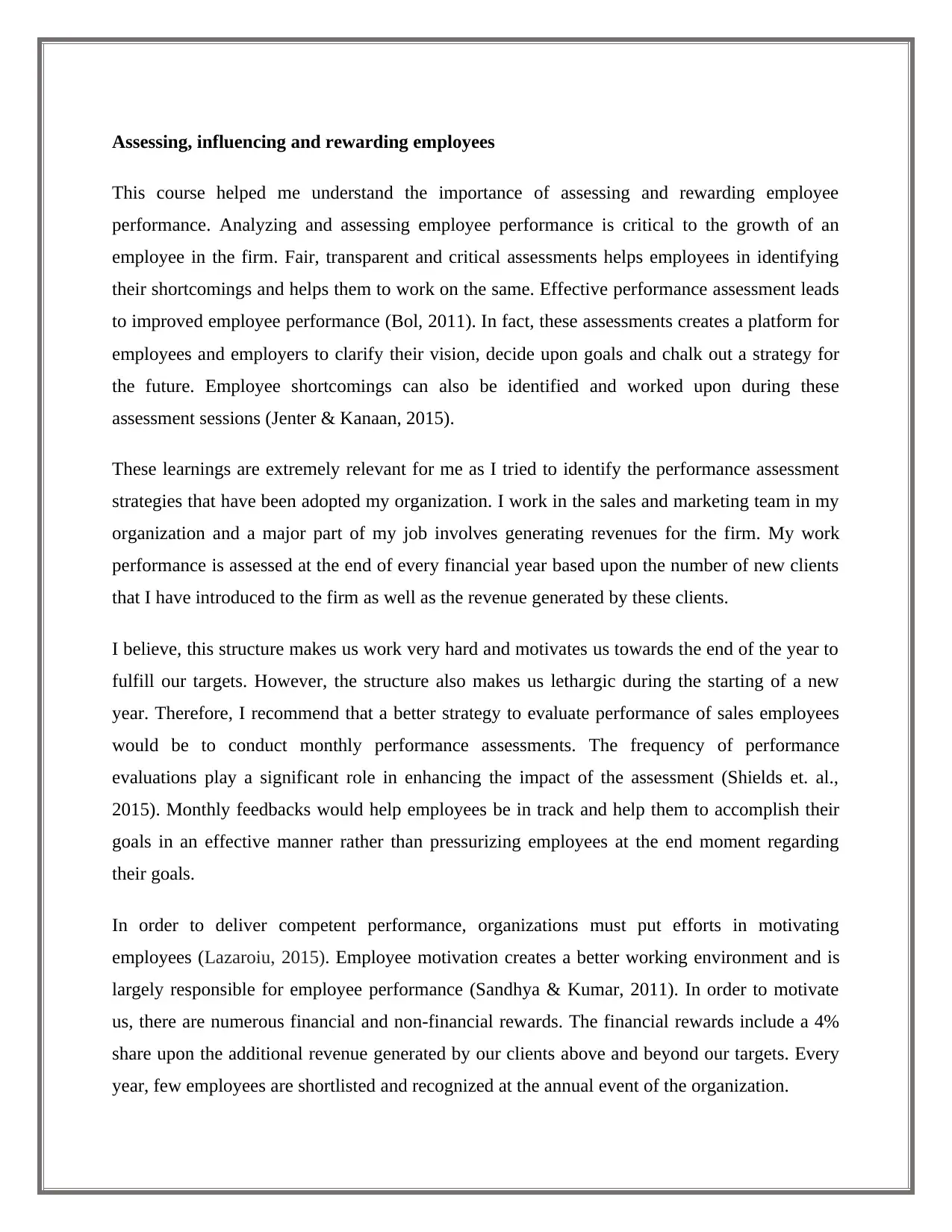
Assessing, influencing and rewarding employees
This course helped me understand the importance of assessing and rewarding employee
performance. Analyzing and assessing employee performance is critical to the growth of an
employee in the firm. Fair, transparent and critical assessments helps employees in identifying
their shortcomings and helps them to work on the same. Effective performance assessment leads
to improved employee performance (Bol, 2011). In fact, these assessments creates a platform for
employees and employers to clarify their vision, decide upon goals and chalk out a strategy for
the future. Employee shortcomings can also be identified and worked upon during these
assessment sessions (Jenter & Kanaan, 2015).
These learnings are extremely relevant for me as I tried to identify the performance assessment
strategies that have been adopted my organization. I work in the sales and marketing team in my
organization and a major part of my job involves generating revenues for the firm. My work
performance is assessed at the end of every financial year based upon the number of new clients
that I have introduced to the firm as well as the revenue generated by these clients.
I believe, this structure makes us work very hard and motivates us towards the end of the year to
fulfill our targets. However, the structure also makes us lethargic during the starting of a new
year. Therefore, I recommend that a better strategy to evaluate performance of sales employees
would be to conduct monthly performance assessments. The frequency of performance
evaluations play a significant role in enhancing the impact of the assessment (Shields et. al.,
2015). Monthly feedbacks would help employees be in track and help them to accomplish their
goals in an effective manner rather than pressurizing employees at the end moment regarding
their goals.
In order to deliver competent performance, organizations must put efforts in motivating
employees (Lazaroiu, 2015). Employee motivation creates a better working environment and is
largely responsible for employee performance (Sandhya & Kumar, 2011). In order to motivate
us, there are numerous financial and non-financial rewards. The financial rewards include a 4%
share upon the additional revenue generated by our clients above and beyond our targets. Every
year, few employees are shortlisted and recognized at the annual event of the organization.
This course helped me understand the importance of assessing and rewarding employee
performance. Analyzing and assessing employee performance is critical to the growth of an
employee in the firm. Fair, transparent and critical assessments helps employees in identifying
their shortcomings and helps them to work on the same. Effective performance assessment leads
to improved employee performance (Bol, 2011). In fact, these assessments creates a platform for
employees and employers to clarify their vision, decide upon goals and chalk out a strategy for
the future. Employee shortcomings can also be identified and worked upon during these
assessment sessions (Jenter & Kanaan, 2015).
These learnings are extremely relevant for me as I tried to identify the performance assessment
strategies that have been adopted my organization. I work in the sales and marketing team in my
organization and a major part of my job involves generating revenues for the firm. My work
performance is assessed at the end of every financial year based upon the number of new clients
that I have introduced to the firm as well as the revenue generated by these clients.
I believe, this structure makes us work very hard and motivates us towards the end of the year to
fulfill our targets. However, the structure also makes us lethargic during the starting of a new
year. Therefore, I recommend that a better strategy to evaluate performance of sales employees
would be to conduct monthly performance assessments. The frequency of performance
evaluations play a significant role in enhancing the impact of the assessment (Shields et. al.,
2015). Monthly feedbacks would help employees be in track and help them to accomplish their
goals in an effective manner rather than pressurizing employees at the end moment regarding
their goals.
In order to deliver competent performance, organizations must put efforts in motivating
employees (Lazaroiu, 2015). Employee motivation creates a better working environment and is
largely responsible for employee performance (Sandhya & Kumar, 2011). In order to motivate
us, there are numerous financial and non-financial rewards. The financial rewards include a 4%
share upon the additional revenue generated by our clients above and beyond our targets. Every
year, few employees are shortlisted and recognized at the annual event of the organization.
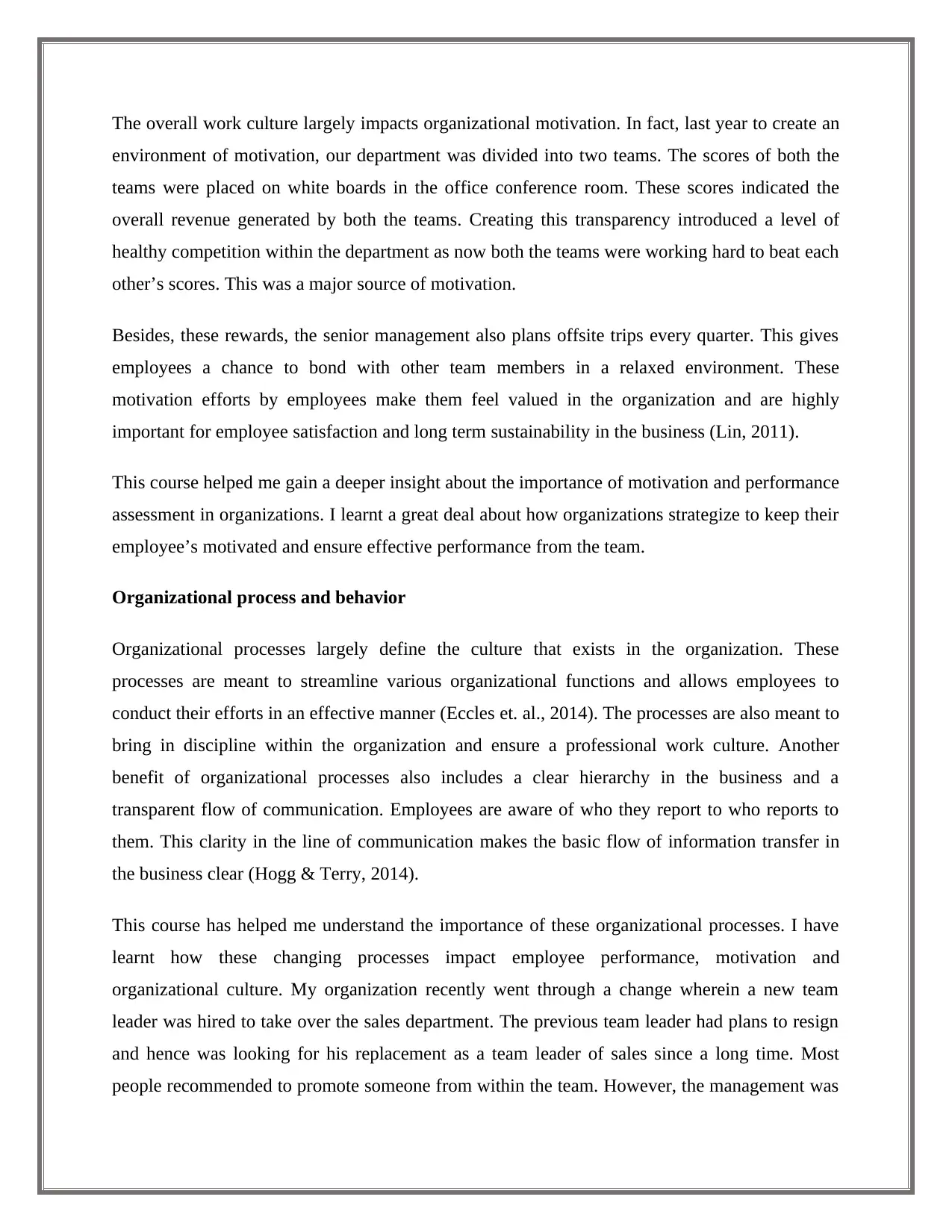
The overall work culture largely impacts organizational motivation. In fact, last year to create an
environment of motivation, our department was divided into two teams. The scores of both the
teams were placed on white boards in the office conference room. These scores indicated the
overall revenue generated by both the teams. Creating this transparency introduced a level of
healthy competition within the department as now both the teams were working hard to beat each
other’s scores. This was a major source of motivation.
Besides, these rewards, the senior management also plans offsite trips every quarter. This gives
employees a chance to bond with other team members in a relaxed environment. These
motivation efforts by employees make them feel valued in the organization and are highly
important for employee satisfaction and long term sustainability in the business (Lin, 2011).
This course helped me gain a deeper insight about the importance of motivation and performance
assessment in organizations. I learnt a great deal about how organizations strategize to keep their
employee’s motivated and ensure effective performance from the team.
Organizational process and behavior
Organizational processes largely define the culture that exists in the organization. These
processes are meant to streamline various organizational functions and allows employees to
conduct their efforts in an effective manner (Eccles et. al., 2014). The processes are also meant to
bring in discipline within the organization and ensure a professional work culture. Another
benefit of organizational processes also includes a clear hierarchy in the business and a
transparent flow of communication. Employees are aware of who they report to who reports to
them. This clarity in the line of communication makes the basic flow of information transfer in
the business clear (Hogg & Terry, 2014).
This course has helped me understand the importance of these organizational processes. I have
learnt how these changing processes impact employee performance, motivation and
organizational culture. My organization recently went through a change wherein a new team
leader was hired to take over the sales department. The previous team leader had plans to resign
and hence was looking for his replacement as a team leader of sales since a long time. Most
people recommended to promote someone from within the team. However, the management was
environment of motivation, our department was divided into two teams. The scores of both the
teams were placed on white boards in the office conference room. These scores indicated the
overall revenue generated by both the teams. Creating this transparency introduced a level of
healthy competition within the department as now both the teams were working hard to beat each
other’s scores. This was a major source of motivation.
Besides, these rewards, the senior management also plans offsite trips every quarter. This gives
employees a chance to bond with other team members in a relaxed environment. These
motivation efforts by employees make them feel valued in the organization and are highly
important for employee satisfaction and long term sustainability in the business (Lin, 2011).
This course helped me gain a deeper insight about the importance of motivation and performance
assessment in organizations. I learnt a great deal about how organizations strategize to keep their
employee’s motivated and ensure effective performance from the team.
Organizational process and behavior
Organizational processes largely define the culture that exists in the organization. These
processes are meant to streamline various organizational functions and allows employees to
conduct their efforts in an effective manner (Eccles et. al., 2014). The processes are also meant to
bring in discipline within the organization and ensure a professional work culture. Another
benefit of organizational processes also includes a clear hierarchy in the business and a
transparent flow of communication. Employees are aware of who they report to who reports to
them. This clarity in the line of communication makes the basic flow of information transfer in
the business clear (Hogg & Terry, 2014).
This course has helped me understand the importance of these organizational processes. I have
learnt how these changing processes impact employee performance, motivation and
organizational culture. My organization recently went through a change wherein a new team
leader was hired to take over the sales department. The previous team leader had plans to resign
and hence was looking for his replacement as a team leader of sales since a long time. Most
people recommended to promote someone from within the team. However, the management was
⊘ This is a preview!⊘
Do you want full access?
Subscribe today to unlock all pages.

Trusted by 1+ million students worldwide
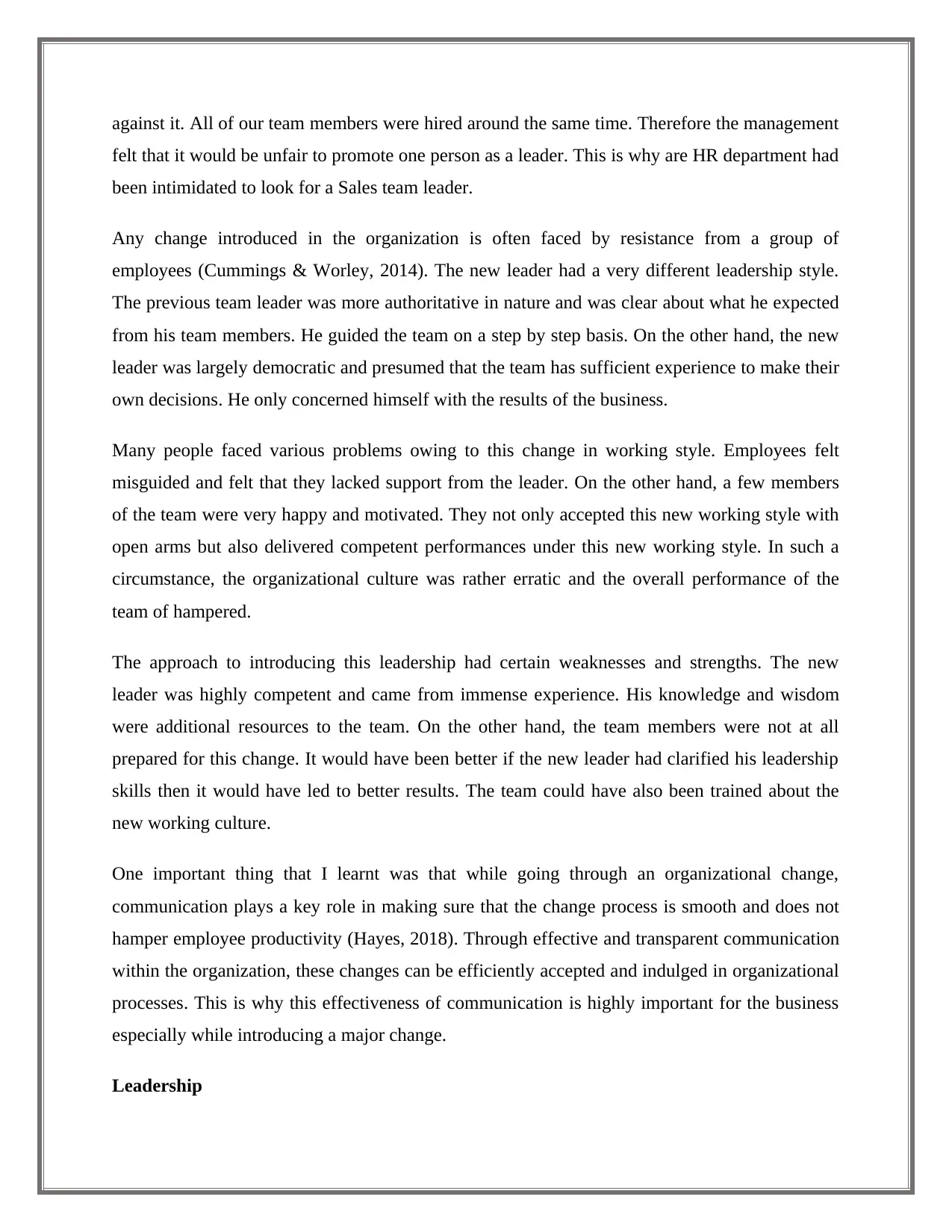
against it. All of our team members were hired around the same time. Therefore the management
felt that it would be unfair to promote one person as a leader. This is why are HR department had
been intimidated to look for a Sales team leader.
Any change introduced in the organization is often faced by resistance from a group of
employees (Cummings & Worley, 2014). The new leader had a very different leadership style.
The previous team leader was more authoritative in nature and was clear about what he expected
from his team members. He guided the team on a step by step basis. On the other hand, the new
leader was largely democratic and presumed that the team has sufficient experience to make their
own decisions. He only concerned himself with the results of the business.
Many people faced various problems owing to this change in working style. Employees felt
misguided and felt that they lacked support from the leader. On the other hand, a few members
of the team were very happy and motivated. They not only accepted this new working style with
open arms but also delivered competent performances under this new working style. In such a
circumstance, the organizational culture was rather erratic and the overall performance of the
team of hampered.
The approach to introducing this leadership had certain weaknesses and strengths. The new
leader was highly competent and came from immense experience. His knowledge and wisdom
were additional resources to the team. On the other hand, the team members were not at all
prepared for this change. It would have been better if the new leader had clarified his leadership
skills then it would have led to better results. The team could have also been trained about the
new working culture.
One important thing that I learnt was that while going through an organizational change,
communication plays a key role in making sure that the change process is smooth and does not
hamper employee productivity (Hayes, 2018). Through effective and transparent communication
within the organization, these changes can be efficiently accepted and indulged in organizational
processes. This is why this effectiveness of communication is highly important for the business
especially while introducing a major change.
Leadership
felt that it would be unfair to promote one person as a leader. This is why are HR department had
been intimidated to look for a Sales team leader.
Any change introduced in the organization is often faced by resistance from a group of
employees (Cummings & Worley, 2014). The new leader had a very different leadership style.
The previous team leader was more authoritative in nature and was clear about what he expected
from his team members. He guided the team on a step by step basis. On the other hand, the new
leader was largely democratic and presumed that the team has sufficient experience to make their
own decisions. He only concerned himself with the results of the business.
Many people faced various problems owing to this change in working style. Employees felt
misguided and felt that they lacked support from the leader. On the other hand, a few members
of the team were very happy and motivated. They not only accepted this new working style with
open arms but also delivered competent performances under this new working style. In such a
circumstance, the organizational culture was rather erratic and the overall performance of the
team of hampered.
The approach to introducing this leadership had certain weaknesses and strengths. The new
leader was highly competent and came from immense experience. His knowledge and wisdom
were additional resources to the team. On the other hand, the team members were not at all
prepared for this change. It would have been better if the new leader had clarified his leadership
skills then it would have led to better results. The team could have also been trained about the
new working culture.
One important thing that I learnt was that while going through an organizational change,
communication plays a key role in making sure that the change process is smooth and does not
hamper employee productivity (Hayes, 2018). Through effective and transparent communication
within the organization, these changes can be efficiently accepted and indulged in organizational
processes. This is why this effectiveness of communication is highly important for the business
especially while introducing a major change.
Leadership
Paraphrase This Document
Need a fresh take? Get an instant paraphrase of this document with our AI Paraphraser
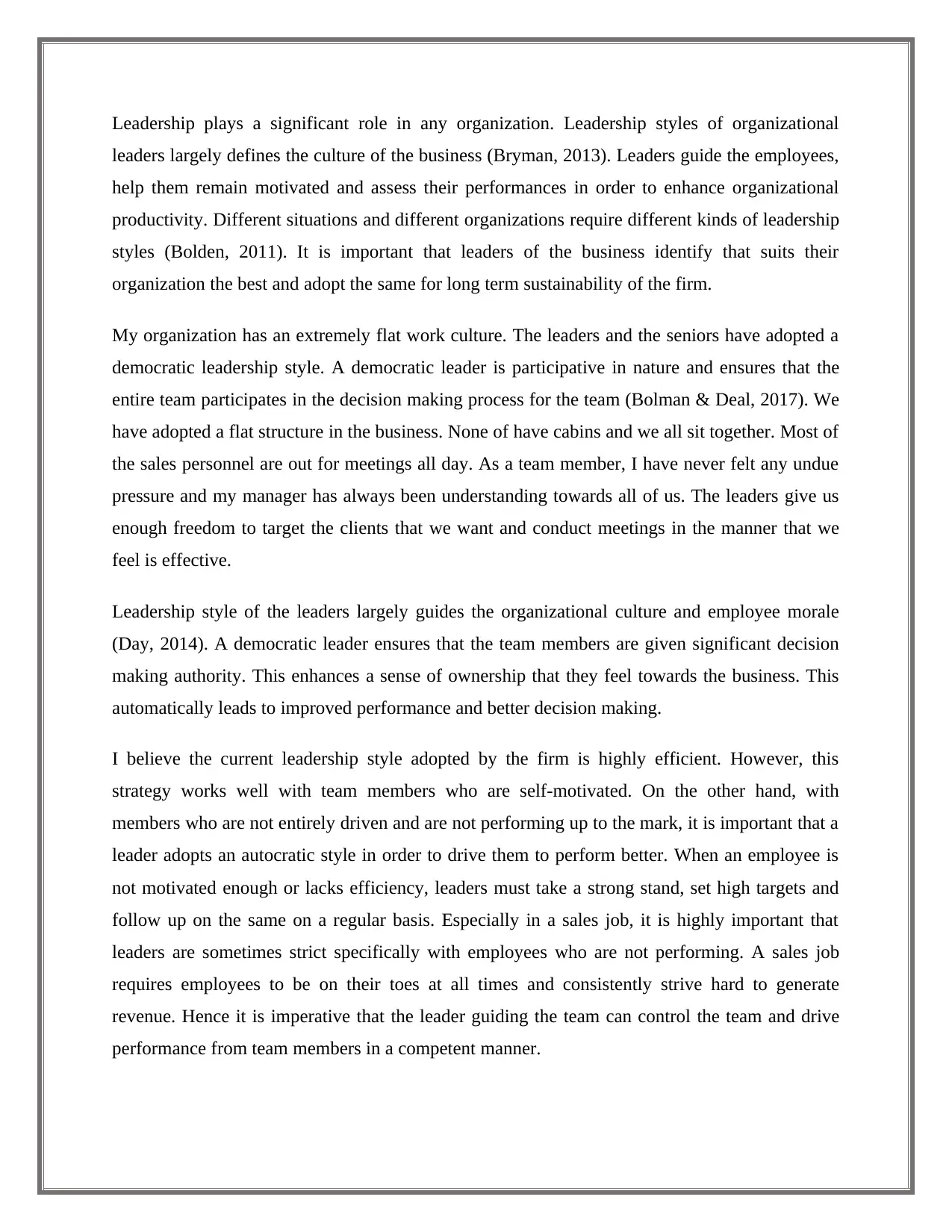
Leadership plays a significant role in any organization. Leadership styles of organizational
leaders largely defines the culture of the business (Bryman, 2013). Leaders guide the employees,
help them remain motivated and assess their performances in order to enhance organizational
productivity. Different situations and different organizations require different kinds of leadership
styles (Bolden, 2011). It is important that leaders of the business identify that suits their
organization the best and adopt the same for long term sustainability of the firm.
My organization has an extremely flat work culture. The leaders and the seniors have adopted a
democratic leadership style. A democratic leader is participative in nature and ensures that the
entire team participates in the decision making process for the team (Bolman & Deal, 2017). We
have adopted a flat structure in the business. None of have cabins and we all sit together. Most of
the sales personnel are out for meetings all day. As a team member, I have never felt any undue
pressure and my manager has always been understanding towards all of us. The leaders give us
enough freedom to target the clients that we want and conduct meetings in the manner that we
feel is effective.
Leadership style of the leaders largely guides the organizational culture and employee morale
(Day, 2014). A democratic leader ensures that the team members are given significant decision
making authority. This enhances a sense of ownership that they feel towards the business. This
automatically leads to improved performance and better decision making.
I believe the current leadership style adopted by the firm is highly efficient. However, this
strategy works well with team members who are self-motivated. On the other hand, with
members who are not entirely driven and are not performing up to the mark, it is important that a
leader adopts an autocratic style in order to drive them to perform better. When an employee is
not motivated enough or lacks efficiency, leaders must take a strong stand, set high targets and
follow up on the same on a regular basis. Especially in a sales job, it is highly important that
leaders are sometimes strict specifically with employees who are not performing. A sales job
requires employees to be on their toes at all times and consistently strive hard to generate
revenue. Hence it is imperative that the leader guiding the team can control the team and drive
performance from team members in a competent manner.
leaders largely defines the culture of the business (Bryman, 2013). Leaders guide the employees,
help them remain motivated and assess their performances in order to enhance organizational
productivity. Different situations and different organizations require different kinds of leadership
styles (Bolden, 2011). It is important that leaders of the business identify that suits their
organization the best and adopt the same for long term sustainability of the firm.
My organization has an extremely flat work culture. The leaders and the seniors have adopted a
democratic leadership style. A democratic leader is participative in nature and ensures that the
entire team participates in the decision making process for the team (Bolman & Deal, 2017). We
have adopted a flat structure in the business. None of have cabins and we all sit together. Most of
the sales personnel are out for meetings all day. As a team member, I have never felt any undue
pressure and my manager has always been understanding towards all of us. The leaders give us
enough freedom to target the clients that we want and conduct meetings in the manner that we
feel is effective.
Leadership style of the leaders largely guides the organizational culture and employee morale
(Day, 2014). A democratic leader ensures that the team members are given significant decision
making authority. This enhances a sense of ownership that they feel towards the business. This
automatically leads to improved performance and better decision making.
I believe the current leadership style adopted by the firm is highly efficient. However, this
strategy works well with team members who are self-motivated. On the other hand, with
members who are not entirely driven and are not performing up to the mark, it is important that a
leader adopts an autocratic style in order to drive them to perform better. When an employee is
not motivated enough or lacks efficiency, leaders must take a strong stand, set high targets and
follow up on the same on a regular basis. Especially in a sales job, it is highly important that
leaders are sometimes strict specifically with employees who are not performing. A sales job
requires employees to be on their toes at all times and consistently strive hard to generate
revenue. Hence it is imperative that the leader guiding the team can control the team and drive
performance from team members in a competent manner.
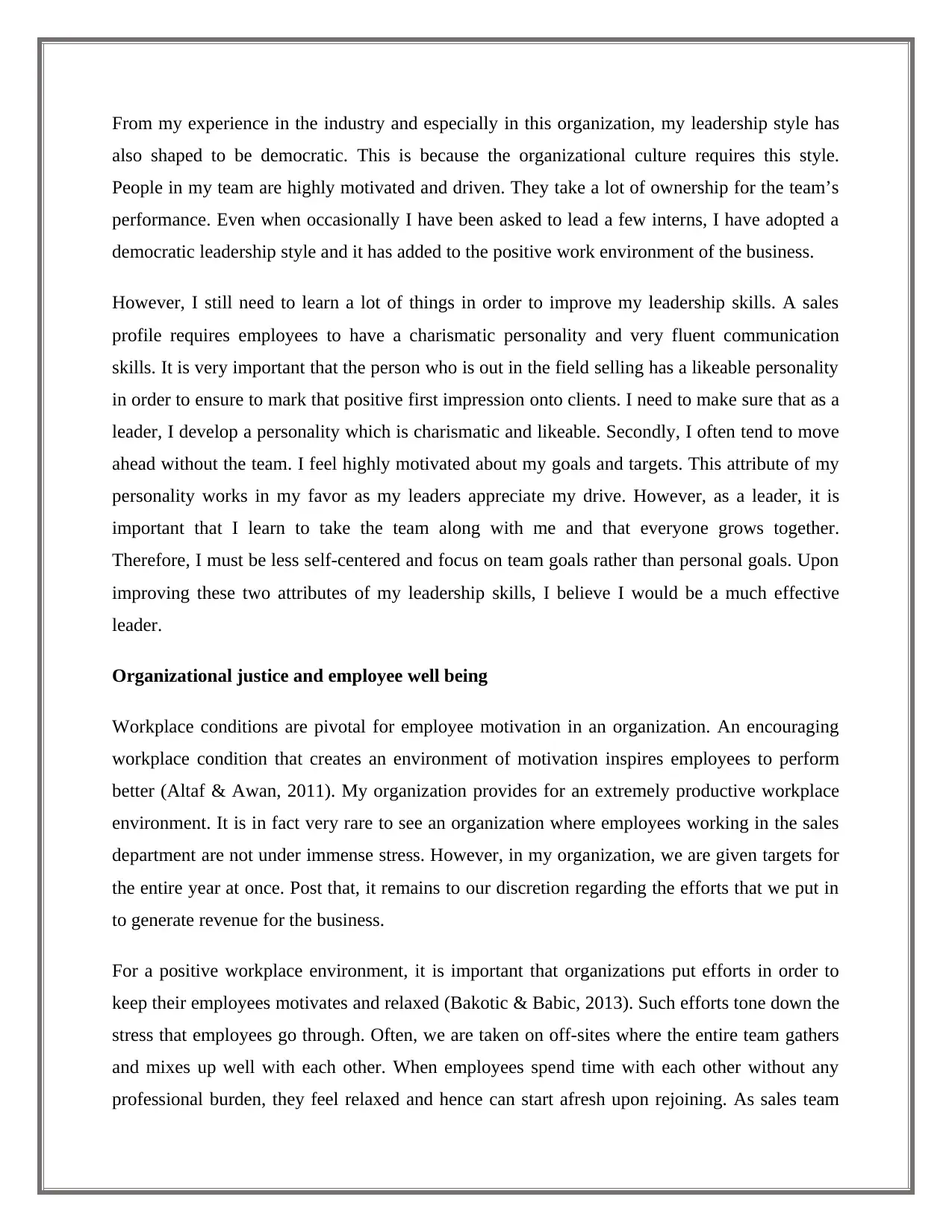
From my experience in the industry and especially in this organization, my leadership style has
also shaped to be democratic. This is because the organizational culture requires this style.
People in my team are highly motivated and driven. They take a lot of ownership for the team’s
performance. Even when occasionally I have been asked to lead a few interns, I have adopted a
democratic leadership style and it has added to the positive work environment of the business.
However, I still need to learn a lot of things in order to improve my leadership skills. A sales
profile requires employees to have a charismatic personality and very fluent communication
skills. It is very important that the person who is out in the field selling has a likeable personality
in order to ensure to mark that positive first impression onto clients. I need to make sure that as a
leader, I develop a personality which is charismatic and likeable. Secondly, I often tend to move
ahead without the team. I feel highly motivated about my goals and targets. This attribute of my
personality works in my favor as my leaders appreciate my drive. However, as a leader, it is
important that I learn to take the team along with me and that everyone grows together.
Therefore, I must be less self-centered and focus on team goals rather than personal goals. Upon
improving these two attributes of my leadership skills, I believe I would be a much effective
leader.
Organizational justice and employee well being
Workplace conditions are pivotal for employee motivation in an organization. An encouraging
workplace condition that creates an environment of motivation inspires employees to perform
better (Altaf & Awan, 2011). My organization provides for an extremely productive workplace
environment. It is in fact very rare to see an organization where employees working in the sales
department are not under immense stress. However, in my organization, we are given targets for
the entire year at once. Post that, it remains to our discretion regarding the efforts that we put in
to generate revenue for the business.
For a positive workplace environment, it is important that organizations put efforts in order to
keep their employees motivates and relaxed (Bakotic & Babic, 2013). Such efforts tone down the
stress that employees go through. Often, we are taken on off-sites where the entire team gathers
and mixes up well with each other. When employees spend time with each other without any
professional burden, they feel relaxed and hence can start afresh upon rejoining. As sales team
also shaped to be democratic. This is because the organizational culture requires this style.
People in my team are highly motivated and driven. They take a lot of ownership for the team’s
performance. Even when occasionally I have been asked to lead a few interns, I have adopted a
democratic leadership style and it has added to the positive work environment of the business.
However, I still need to learn a lot of things in order to improve my leadership skills. A sales
profile requires employees to have a charismatic personality and very fluent communication
skills. It is very important that the person who is out in the field selling has a likeable personality
in order to ensure to mark that positive first impression onto clients. I need to make sure that as a
leader, I develop a personality which is charismatic and likeable. Secondly, I often tend to move
ahead without the team. I feel highly motivated about my goals and targets. This attribute of my
personality works in my favor as my leaders appreciate my drive. However, as a leader, it is
important that I learn to take the team along with me and that everyone grows together.
Therefore, I must be less self-centered and focus on team goals rather than personal goals. Upon
improving these two attributes of my leadership skills, I believe I would be a much effective
leader.
Organizational justice and employee well being
Workplace conditions are pivotal for employee motivation in an organization. An encouraging
workplace condition that creates an environment of motivation inspires employees to perform
better (Altaf & Awan, 2011). My organization provides for an extremely productive workplace
environment. It is in fact very rare to see an organization where employees working in the sales
department are not under immense stress. However, in my organization, we are given targets for
the entire year at once. Post that, it remains to our discretion regarding the efforts that we put in
to generate revenue for the business.
For a positive workplace environment, it is important that organizations put efforts in order to
keep their employees motivates and relaxed (Bakotic & Babic, 2013). Such efforts tone down the
stress that employees go through. Often, we are taken on off-sites where the entire team gathers
and mixes up well with each other. When employees spend time with each other without any
professional burden, they feel relaxed and hence can start afresh upon rejoining. As sales team
⊘ This is a preview!⊘
Do you want full access?
Subscribe today to unlock all pages.

Trusted by 1+ million students worldwide
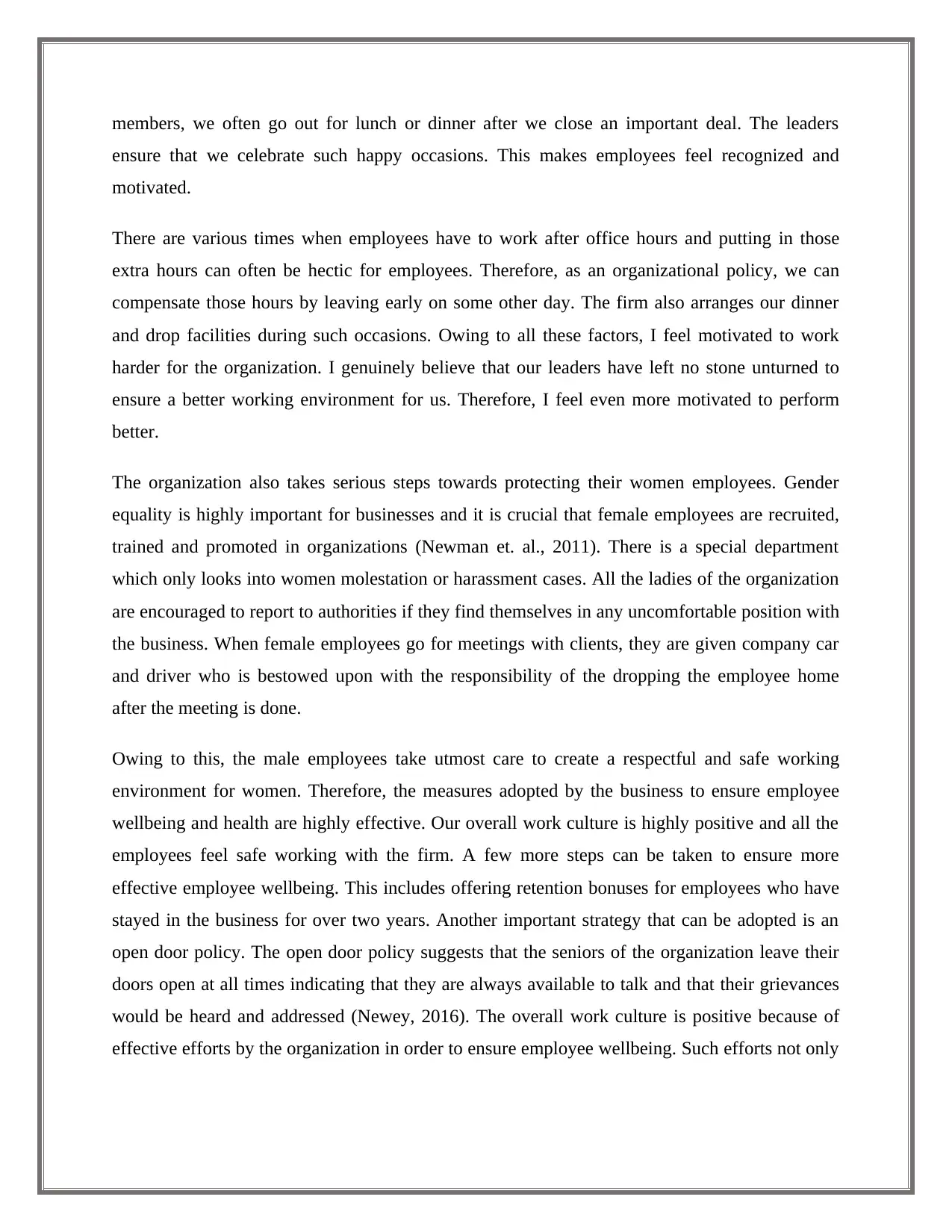
members, we often go out for lunch or dinner after we close an important deal. The leaders
ensure that we celebrate such happy occasions. This makes employees feel recognized and
motivated.
There are various times when employees have to work after office hours and putting in those
extra hours can often be hectic for employees. Therefore, as an organizational policy, we can
compensate those hours by leaving early on some other day. The firm also arranges our dinner
and drop facilities during such occasions. Owing to all these factors, I feel motivated to work
harder for the organization. I genuinely believe that our leaders have left no stone unturned to
ensure a better working environment for us. Therefore, I feel even more motivated to perform
better.
The organization also takes serious steps towards protecting their women employees. Gender
equality is highly important for businesses and it is crucial that female employees are recruited,
trained and promoted in organizations (Newman et. al., 2011). There is a special department
which only looks into women molestation or harassment cases. All the ladies of the organization
are encouraged to report to authorities if they find themselves in any uncomfortable position with
the business. When female employees go for meetings with clients, they are given company car
and driver who is bestowed upon with the responsibility of the dropping the employee home
after the meeting is done.
Owing to this, the male employees take utmost care to create a respectful and safe working
environment for women. Therefore, the measures adopted by the business to ensure employee
wellbeing and health are highly effective. Our overall work culture is highly positive and all the
employees feel safe working with the firm. A few more steps can be taken to ensure more
effective employee wellbeing. This includes offering retention bonuses for employees who have
stayed in the business for over two years. Another important strategy that can be adopted is an
open door policy. The open door policy suggests that the seniors of the organization leave their
doors open at all times indicating that they are always available to talk and that their grievances
would be heard and addressed (Newey, 2016). The overall work culture is positive because of
effective efforts by the organization in order to ensure employee wellbeing. Such efforts not only
ensure that we celebrate such happy occasions. This makes employees feel recognized and
motivated.
There are various times when employees have to work after office hours and putting in those
extra hours can often be hectic for employees. Therefore, as an organizational policy, we can
compensate those hours by leaving early on some other day. The firm also arranges our dinner
and drop facilities during such occasions. Owing to all these factors, I feel motivated to work
harder for the organization. I genuinely believe that our leaders have left no stone unturned to
ensure a better working environment for us. Therefore, I feel even more motivated to perform
better.
The organization also takes serious steps towards protecting their women employees. Gender
equality is highly important for businesses and it is crucial that female employees are recruited,
trained and promoted in organizations (Newman et. al., 2011). There is a special department
which only looks into women molestation or harassment cases. All the ladies of the organization
are encouraged to report to authorities if they find themselves in any uncomfortable position with
the business. When female employees go for meetings with clients, they are given company car
and driver who is bestowed upon with the responsibility of the dropping the employee home
after the meeting is done.
Owing to this, the male employees take utmost care to create a respectful and safe working
environment for women. Therefore, the measures adopted by the business to ensure employee
wellbeing and health are highly effective. Our overall work culture is highly positive and all the
employees feel safe working with the firm. A few more steps can be taken to ensure more
effective employee wellbeing. This includes offering retention bonuses for employees who have
stayed in the business for over two years. Another important strategy that can be adopted is an
open door policy. The open door policy suggests that the seniors of the organization leave their
doors open at all times indicating that they are always available to talk and that their grievances
would be heard and addressed (Newey, 2016). The overall work culture is positive because of
effective efforts by the organization in order to ensure employee wellbeing. Such efforts not only
Paraphrase This Document
Need a fresh take? Get an instant paraphrase of this document with our AI Paraphraser
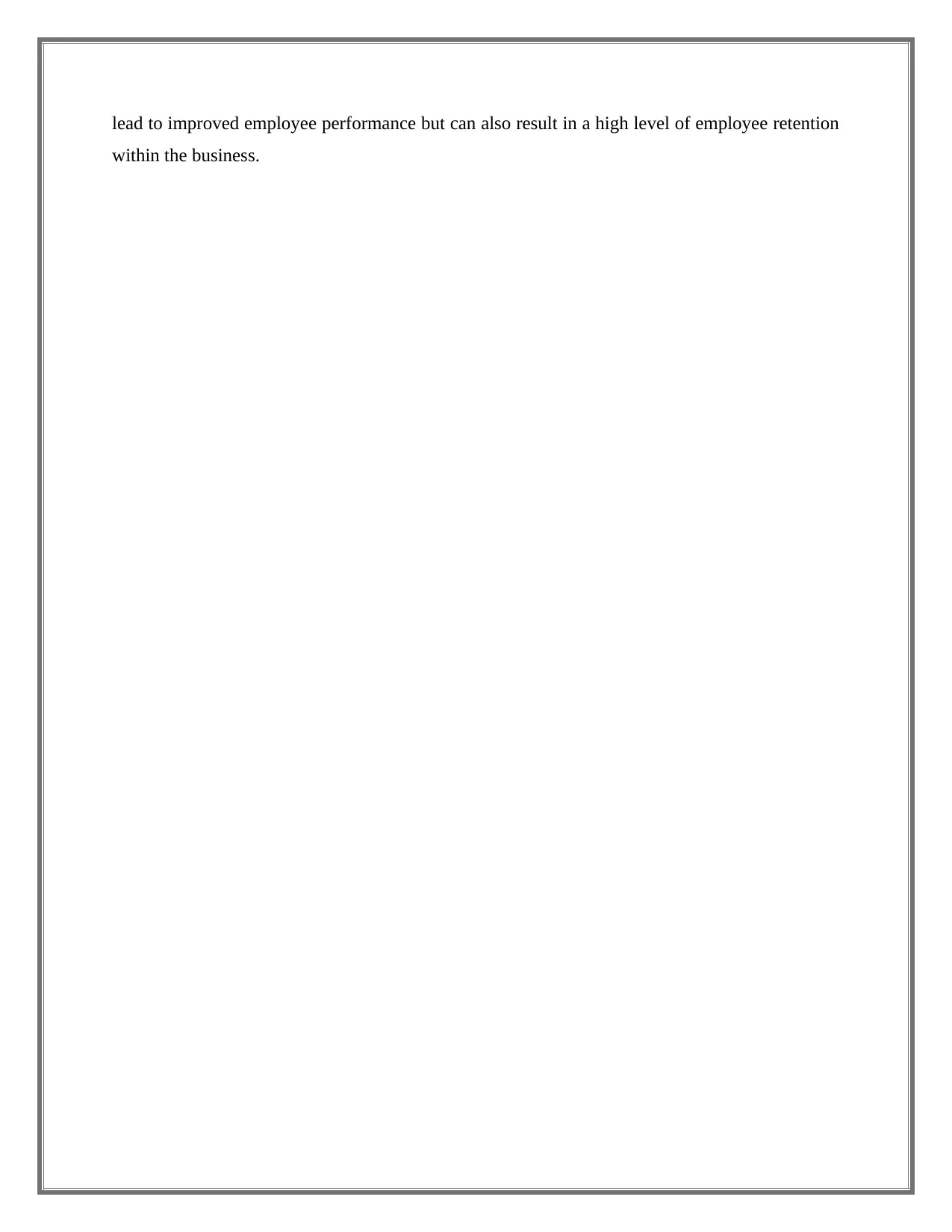
lead to improved employee performance but can also result in a high level of employee retention
within the business.
within the business.
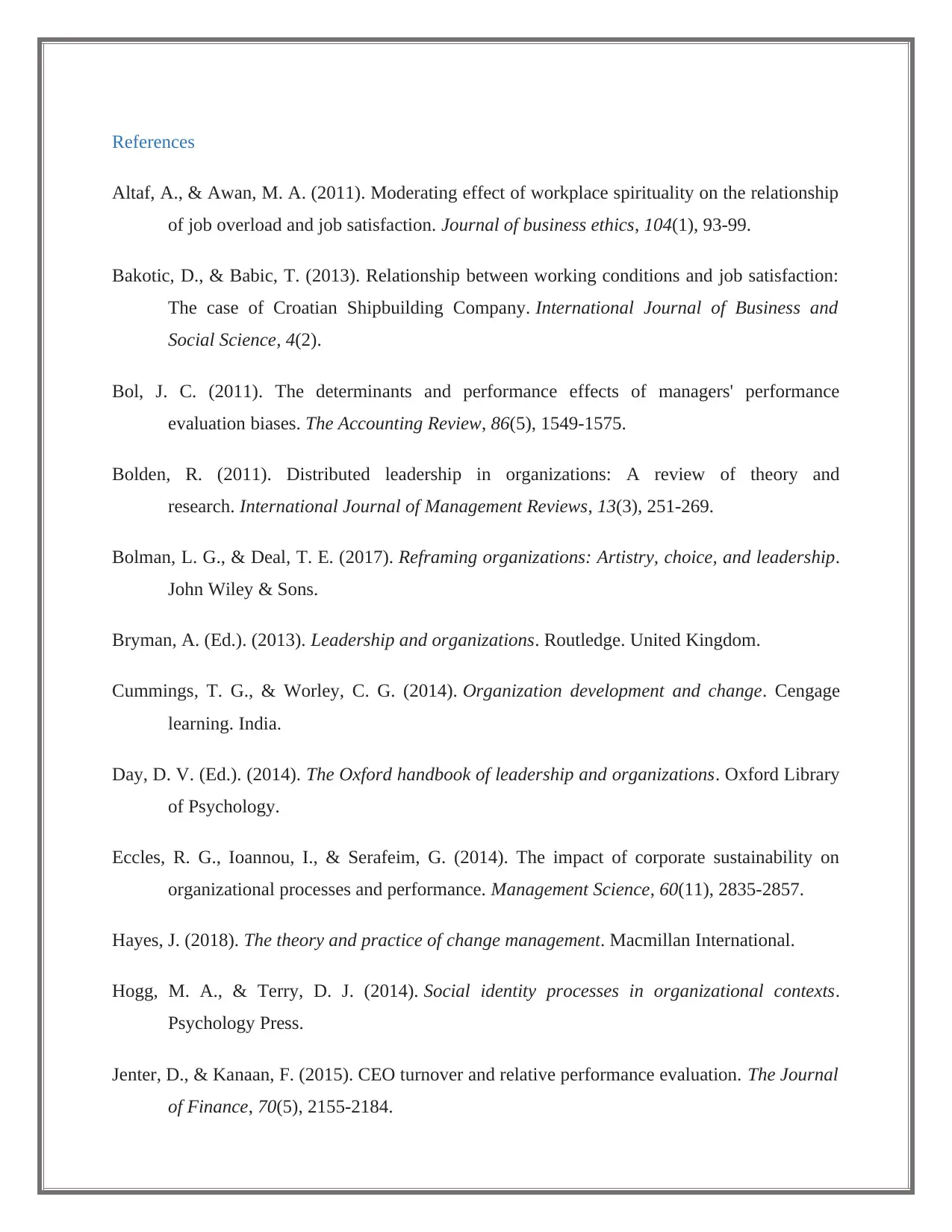
References
Altaf, A., & Awan, M. A. (2011). Moderating effect of workplace spirituality on the relationship
of job overload and job satisfaction. Journal of business ethics, 104(1), 93-99.
Bakotic, D., & Babic, T. (2013). Relationship between working conditions and job satisfaction:
The case of Croatian Shipbuilding Company. International Journal of Business and
Social Science, 4(2).
Bol, J. C. (2011). The determinants and performance effects of managers' performance
evaluation biases. The Accounting Review, 86(5), 1549-1575.
Bolden, R. (2011). Distributed leadership in organizations: A review of theory and
research. International Journal of Management Reviews, 13(3), 251-269.
Bolman, L. G., & Deal, T. E. (2017). Reframing organizations: Artistry, choice, and leadership.
John Wiley & Sons.
Bryman, A. (Ed.). (2013). Leadership and organizations. Routledge. United Kingdom.
Cummings, T. G., & Worley, C. G. (2014). Organization development and change. Cengage
learning. India.
Day, D. V. (Ed.). (2014). The Oxford handbook of leadership and organizations. Oxford Library
of Psychology.
Eccles, R. G., Ioannou, I., & Serafeim, G. (2014). The impact of corporate sustainability on
organizational processes and performance. Management Science, 60(11), 2835-2857.
Hayes, J. (2018). The theory and practice of change management. Macmillan International.
Hogg, M. A., & Terry, D. J. (2014). Social identity processes in organizational contexts.
Psychology Press.
Jenter, D., & Kanaan, F. (2015). CEO turnover and relative performance evaluation. The Journal
of Finance, 70(5), 2155-2184.
Altaf, A., & Awan, M. A. (2011). Moderating effect of workplace spirituality on the relationship
of job overload and job satisfaction. Journal of business ethics, 104(1), 93-99.
Bakotic, D., & Babic, T. (2013). Relationship between working conditions and job satisfaction:
The case of Croatian Shipbuilding Company. International Journal of Business and
Social Science, 4(2).
Bol, J. C. (2011). The determinants and performance effects of managers' performance
evaluation biases. The Accounting Review, 86(5), 1549-1575.
Bolden, R. (2011). Distributed leadership in organizations: A review of theory and
research. International Journal of Management Reviews, 13(3), 251-269.
Bolman, L. G., & Deal, T. E. (2017). Reframing organizations: Artistry, choice, and leadership.
John Wiley & Sons.
Bryman, A. (Ed.). (2013). Leadership and organizations. Routledge. United Kingdom.
Cummings, T. G., & Worley, C. G. (2014). Organization development and change. Cengage
learning. India.
Day, D. V. (Ed.). (2014). The Oxford handbook of leadership and organizations. Oxford Library
of Psychology.
Eccles, R. G., Ioannou, I., & Serafeim, G. (2014). The impact of corporate sustainability on
organizational processes and performance. Management Science, 60(11), 2835-2857.
Hayes, J. (2018). The theory and practice of change management. Macmillan International.
Hogg, M. A., & Terry, D. J. (2014). Social identity processes in organizational contexts.
Psychology Press.
Jenter, D., & Kanaan, F. (2015). CEO turnover and relative performance evaluation. The Journal
of Finance, 70(5), 2155-2184.
⊘ This is a preview!⊘
Do you want full access?
Subscribe today to unlock all pages.

Trusted by 1+ million students worldwide
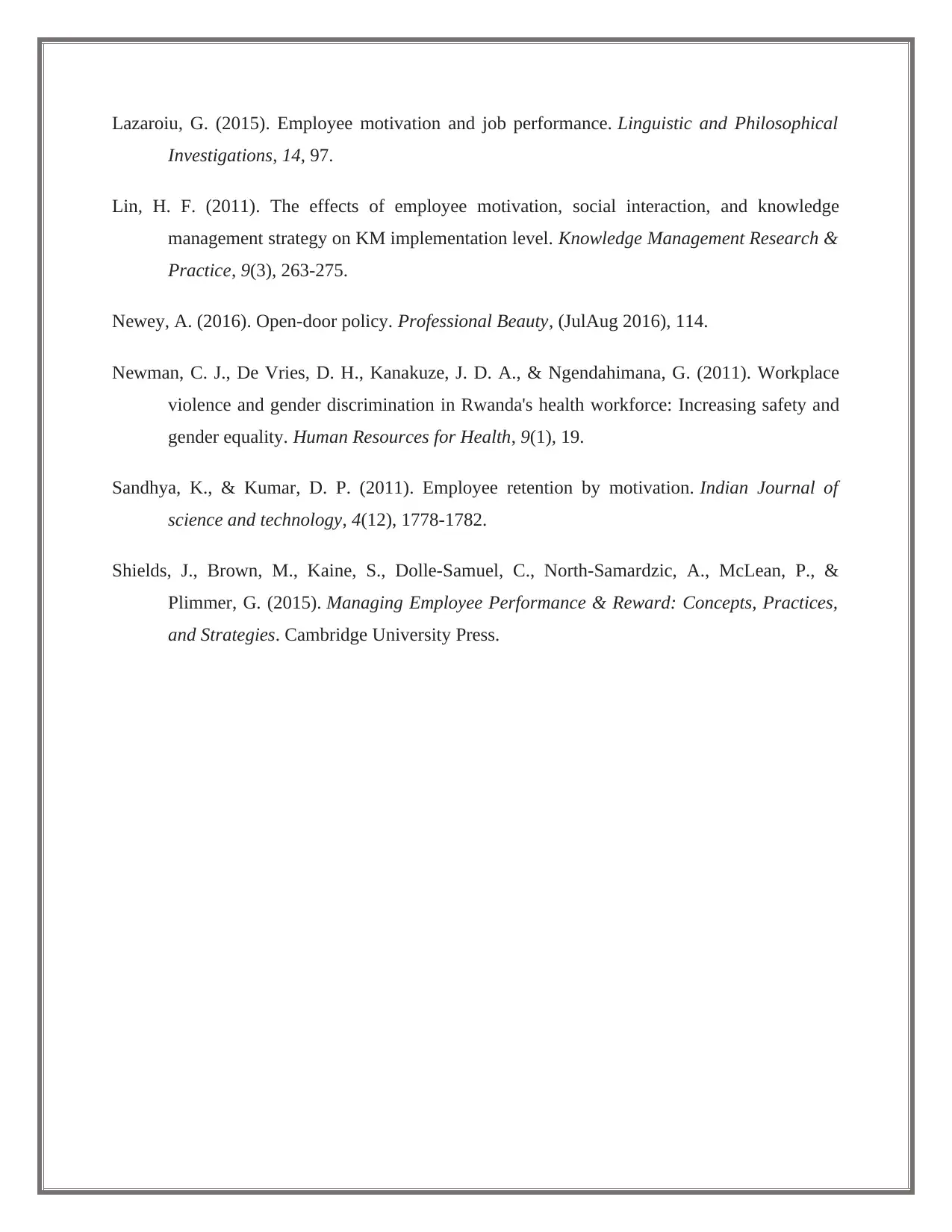
Lazaroiu, G. (2015). Employee motivation and job performance. Linguistic and Philosophical
Investigations, 14, 97.
Lin, H. F. (2011). The effects of employee motivation, social interaction, and knowledge
management strategy on KM implementation level. Knowledge Management Research &
Practice, 9(3), 263-275.
Newey, A. (2016). Open-door policy. Professional Beauty, (JulAug 2016), 114.
Newman, C. J., De Vries, D. H., Kanakuze, J. D. A., & Ngendahimana, G. (2011). Workplace
violence and gender discrimination in Rwanda's health workforce: Increasing safety and
gender equality. Human Resources for Health, 9(1), 19.
Sandhya, K., & Kumar, D. P. (2011). Employee retention by motivation. Indian Journal of
science and technology, 4(12), 1778-1782.
Shields, J., Brown, M., Kaine, S., Dolle-Samuel, C., North-Samardzic, A., McLean, P., &
Plimmer, G. (2015). Managing Employee Performance & Reward: Concepts, Practices,
and Strategies. Cambridge University Press.
Investigations, 14, 97.
Lin, H. F. (2011). The effects of employee motivation, social interaction, and knowledge
management strategy on KM implementation level. Knowledge Management Research &
Practice, 9(3), 263-275.
Newey, A. (2016). Open-door policy. Professional Beauty, (JulAug 2016), 114.
Newman, C. J., De Vries, D. H., Kanakuze, J. D. A., & Ngendahimana, G. (2011). Workplace
violence and gender discrimination in Rwanda's health workforce: Increasing safety and
gender equality. Human Resources for Health, 9(1), 19.
Sandhya, K., & Kumar, D. P. (2011). Employee retention by motivation. Indian Journal of
science and technology, 4(12), 1778-1782.
Shields, J., Brown, M., Kaine, S., Dolle-Samuel, C., North-Samardzic, A., McLean, P., &
Plimmer, G. (2015). Managing Employee Performance & Reward: Concepts, Practices,
and Strategies. Cambridge University Press.
1 out of 10
Related Documents
Your All-in-One AI-Powered Toolkit for Academic Success.
+13062052269
info@desklib.com
Available 24*7 on WhatsApp / Email
![[object Object]](/_next/static/media/star-bottom.7253800d.svg)
Unlock your academic potential
Copyright © 2020–2025 A2Z Services. All Rights Reserved. Developed and managed by ZUCOL.





